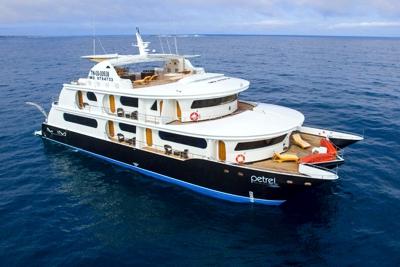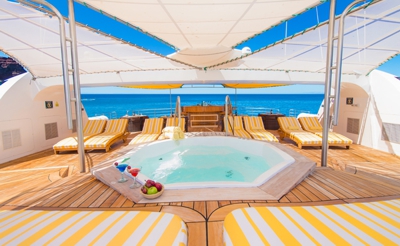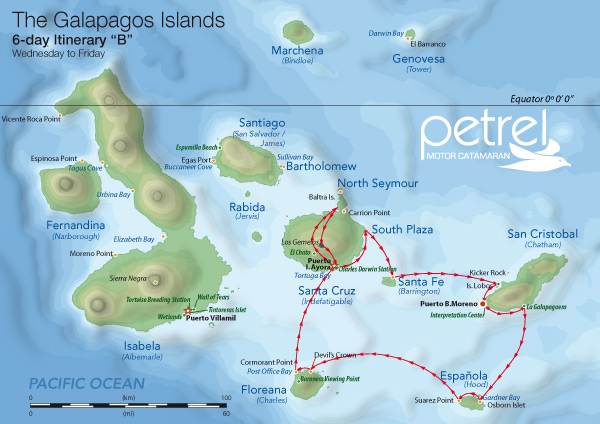

Destinations
Experiences
 |
L A
D A T C O T O U R
S |
 |
||||||||
| HOME | South America | Falkland Islands | Antarctica | Unique Destinations |
Unique Experiences |
Newsstand | ||||
 |
GALAPAGOS ISLANDS
Petrel
|
 |
||||||
|
Itinerary "6B" |

Day 1 (Wednesday)
FROM QUITO OR GUAYAQUIL TO BALTRA
Assistance will be provided for you when you arrive to the airport by one of our representatives after you have landed.AM. Baltra Island
You will arrive at Baltra Island in the morning. After passing through immigration and baggage claim you will be met by Petrel staff and transferred to the yacht. You will be shown to your cabin where you will have some time to settle in before lunch and a welcome briefing.PM. Los Gemelos “Twin Craters” (Santa Cruz Island)
You’ll also visit the highlands. A place you can walk along a path, observing the hills, ferns, volcanoes, and rich wildlife. This area is home to giant tortoises, forest, mockingbirds, Bahama ducklings, White-cheeked Pintail ducklings, Darwin finches, and many other species. You will come upon the underground lava tubes, which are more than one kilometer (half a mile) long. Local guides are will provide information and flashlights. Walking through the lava tubes is a unique and surreal experience.
|
Highlights: |
Pit craters, Scalesia Forest |
|
Possible Activities: |
Short hiking |
|
Type of Landing: |
Dry landing |
|
Difficulty: |
Moderate |
Day 2 (Thursday)
AM. South Plaza Island
In the morning, you will head to South Plaza Island. This small island with steep cliffs was formed by rising lava and is now covered by Opuntia cacti. It is also home to one of the largest sea lion colonies as well as colorful yellow and red land iguanas. The most characteristic plant is the Sesuvium. During the rainy season its color is a greenish to yellowish tone and in the dry season (end of June through January) a bright red.
|
Highlights: |
Land iguanas, sea lion colony, Audubon's shearwaters, Swallow=tailed Gulls, Nazca Boobies, Amazing landscape with cliffs |
|
Possible Activities: |
Hike (2 1/2 km / 1.5 miles) |
|
Type of Landing: |
Dry Landing |
|
Difficulty: |
Moderate |
PM. Santa Fe Island
Santa Fe (Barrington) is home to the small picturesque bay and anchorage on the island’s northeast coast. The bay has two visitor trails, one leading to a scenic viewpoint atop a cliff, and the other spanning from a small beach to a tall prickly pear cactus forest.
|
Highlights: |
Land iguanas, giant tunas. |
|
Possible Activities: |
Hiking |
|
Type of Landing: |
Dry Landing |
|
Difficulty: |
Moderate |
Day 3 (Friday)
AM. Lobos Island (San Cristobal Island)
Isla Lobos or Lobos Island is named after the sea lions that rest and play on its rocky shores. It is also home to blue-footed boobies, great frigate-birds, brown pelicans, lava gulls, common noddies, yellow warblers and small and medium ground finches. There is good snorkeling in the clear waters of the channel and this is one of the best sites at which to swim with sea lions underwater.
Highlights:
Snorkeling with sea lions, frigatebirds, Blue-Footed Boobies
Possible Activities:
Short hike (less than 0,6 mile / 1 km), dinghy ride, snorkeling
Type of Landing:
Dry Landing
Difficulty:
Easy, moderate
PM. Interpretation Center (San Cristobal Island)
The Interpretation Center was opened in 1998 as a phase of the project “Interpretation and Environment Education Project.” Visitors enjoy expositions on natural history, human history, and conservation. The conservation efforts represent the movement to protect the wildlife and natural environment through means of population and tourist control. The Interpretation Center has an outdoor stadium, audio-visual equipment, and meeting rooms.
Highlights:
Interactive exhibits
Possible Activities:
Short walk
Type of Landing:
Dry Landing
Difficulty:
Easy
PM. La Galapaguera (San Cristobal Island)
A visitor site in the southeast part of San Cristobal Island that can be reached in roughly one hour by road from Puerto Baquerizo Moreno. On the trees and shrubs surrounding the site, you may see land birds like warbler, finches and mockingbirds, and on the trails, Giant Tortoises.
Highlights:
IGiant tortoises in captivity, land birds
Possible Activities:
Short walk
Type of Landing:
Dry Landing
Difficulty:
Easy
Day 4 (Saturday)
AM. Gardner Bay (Española Island)
Gardner Bay, on the eastern side of the island, is the breeding site of nearly all of the world´s 12,000 pairs of Waved Albatrosses. It has an ample white sandy beach with a myriad of sea lions, perfect for relaxing. Its rocky shores make this site a great place for diving and snorkeling.
Highlights:
White sandy beach, sea lions, mockingbirds, snorkeling, colorful fish, sea lion nursery
Possible Activities:
Snorkeling, dinghy ride, kayaking and short hike (0.6 mi / 1 km)
Type of Landing:
Wet Landing
Difficulty:
Easy
AM. Osborn Islet (Española Island)
After landing, you can walk across a lovely white sand beach amongst a busy sea lion colony or dive into the water to swim with sea lion pups. This small island is a marine visit where you can enjoy fantastic snorkeling and swimming.
Highlights:
White sandy beach, sea lions, mockingbirds
Possible Activities:
Snorkeling, dinghy ride, kayaking and short hike (0.6 mi / 1 km)
Type of Landing:
Wet Landing
Difficulty:
Easy
PM. Suarez Point (Española Island)
This area is great for spotting Blue-footed Boobies, albatrosses and Nazca Boobies. A beautiful site on the ocean front, the large Waved Albatrosses use the cliff as a launching pad. The famous attraction is the magnificent blowhole, spurting water high into the air. This site presents wonderful photograph opportunities.
|
Highlights: |
Hood Mockingbird, Nazca Boobies, Waved Albatross, Red-billed tropicbirds, lava lizards, Galapagos Hawk, Blue-footed Boobies, blow hole, amazing landscape |
|
Possible Activities: |
Hike (1.9 mi/3 km) |
|
Type of Landing: |
Dry Landing |
|
Difficulty: |
Difficult |
Day 5 (Sunday)
AM. Cormorant Point (Floreana Island)
This site hosts a large flamingo lagoon where other birds such as common stilts, White-cheeked Pintails can also be seen. The beaches on this island are distinct: The “Green Beach” named so due to its green color, which comes from a high percentage of olivine crystals in the sand, and the “Four Sand Beach” composed of white coral.
|
Highlights: |
Flamingoes, green-colored beach |
|
Possible Activities: |
Dinghy ride & hike (1.2 mi /2 km) |
|
Type of Landing: |
Wet landing |
|
Difficulty: |
Easy |
AM. Devil’s Crown (Floreana Island)
One of the best snorkeling sites in the Galapagos, this volcanic crater has been eroded by the waves leaving the northern and southern sides poking out of the water. The coral reef in the middle is perfect for attracting marine life. Snorkelers enjoy the variety of marine life and exciting currents that rush through the crown, creating an exhilarating experience.
|
Highlights: |
The best snorkeling site in Galapagos Islands with sharks, rays, rock formations, lots of tropical fish. |
|
Possible Activities: |
Snorkeling |
|
Type of Landing: |
No landing |
|
Difficulty: |
Moderate/difficult |
PM. Post Office Bay (Floreana Island)
In the 18th century whalers passing through the islands placed a wooden barrel on Floreana Island for use as an unofficial mail box. The tradition continues today as visitors leave addressed postcards in the barrel and sort through left mail to deliver at home.
|
Highlights: |
Barrel Post Office, nice sandy beach |
|
Possible Activities: |
Short hike (less than 0.6 mi/1 km) & snorkeling |
|
Type of Landing: |
Wet landing |
|
Difficulty: |
Easy |
Day 6 (Monday)
AM. Charles Darwin Station (Santa Cruz Island)
The Charles Darwin Research Station is home to turtles ranging from 3-inches (new hatchlings) to 4-feet long. Sub-species of turtles interact with one another and many of the older turtles are accustomed to humans, stretching out their heads for a pet. The babies are kept until they are about four years old and strong enough to survive on their own.
|
Highlights: |
Giant Tortoises in captivation |
|
Possible Activities: |
Walking |
|
Type of Landing: |
Dry landing |
|
Difficulty: |
Easy |
AM. Transfer to the airport (Baltra Island)
Please keep in mind that on departures days, your morning visit will be early and short since we need to be prepared before heading back toward the airport for your returning flight to Ecuador’s mainland.IMPORTANT:
Itineraries and activities subject to change without prior notice. Depending on weather conditions and water currents, some wildlife described above may not be visible